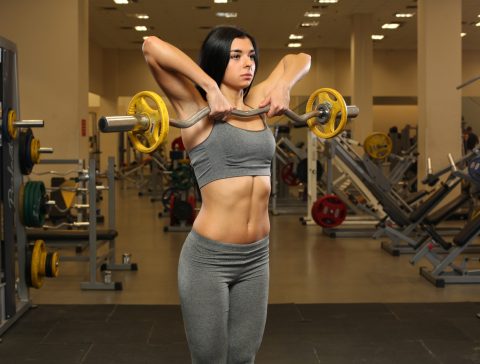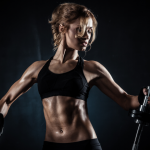The upright barbell row (row) is one of those exercises that most visitors to the gym do not pay enough attention to. Well, this exercise brings tangible results. But the fact of the matter is that the pulling weights up to the Winny Munoz chin are the best exercise aimed at creating a broad-shouldered silhouette. Unlike traditional presses, here it is possible to purposefully improve the shoulders, which increases their width.
Even 15-20 years ago, lifting enjoyed well-deserved respect. With the development of new equipment, the basic barbell movement exercises moved to the background. And modern youth, who purchase gym subscriptions, do not pay attention to powerful basic elements.
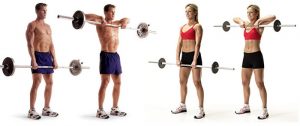
Pros and Cons of This Exercise
The row is a basic exercise that involves several exercises that work for biceps muscle groups at once. And such movements are always difficult to carry out. Partly, therefore, most of those involved successfully finding an alternative to them where possible. The row was replaced by dumbbells in the sides, work on block simulators, and pressure on the classic barbell presses.
Harm to exercise
But ignoring traction is sometimes explained and a good reason – problems with shoulders. This exercise can not be called safe. When performed with the wrong technique it is quite capable of leading to a subacromial syndrome of the shoulder joint. The articular rotator cuff is damaged, which causes severe pain and does not allow the shoulders to move away. Pain is the result of the pressure of the scapula on the rotator cuff when the arm is raised.
In this syndrome, the biomechanics of the shoulder joints fail, and the choice of exercises for the deltas becomes limited. In some cases, athletes generally have to give up loads on the shoulders.
Due to trauma, the row must be carried out very technically and after a thorough warm-up. And if problems with the shoulders already take place, you need to do the same as the modern average visitor to the gym – forget about this exercise until the condition of the joints improves.
What can I do instead? If the problems are serious, then you should not load your shoulders at all. For problems of a smaller scale, you should use dumbbells and other equipment. In such situations, it is important to minimize the mobility of the joints. During the row, the trajectory is fixed, the movement of the hands determines the height of the bar. Using dumbbells, you can load the shoulders, and allow the joints to work in a freer mode.
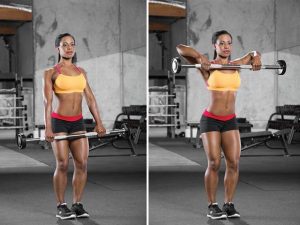
Use of traction
The row allows you to achieve:
- Wide shoulders – among the basic exercises there is no one that could compete with the row in terms of the increasing size of the deltoids
- Improved strength of the deltoids and trapezius; in fact, rowing is two exercises in one. If you vary the setting of hands, you can achieve a concentrated load on a particular zone;
- Increase in strength
- Improves performance in other sports. The row is actively used by wrestlers, gymnasts, basketball players, and players of other sports.
Which muscles can I build?
Stretching is a multi-joint exercise that involves the deltoid and trapezius. Which muscles will be worked:
| Muscles | Location: | Function in Exercise |
| The average deltoids | Tops the shoulder joint | Keep the arm up and away from the body |
| Trapezoidal (trapezoid) | The rhomboid muscle in the center of the upper back | Raise the shoulder blade and rotate it from the spine to the outside |
| Shoulder blade | The back of the neck, topped by the trapezius | Raise the shoulder joint and shoulder blade |
| Front deltoids | Covers the upper and the front of the shoulder joint | Bend the shoulder and move the upper part of the hand up and forward |
| Trapezius | The deep muscle of the upper back, covered with deltoids and attached to the humerus | Move shoulder to the side at the start of the row |
| Top of the pectoralis major | Covers the upper zone of the chest | Helps to lift the shoulder (the upper arm – from the shoulder to the elbow) |
| Biceps | Bends the arm at the elbow and turns the forearm | |
| Thorax | It covers the ribs (lateral part of the thorax) | Lift the shoulder blade and turn it outward |
Types of exercise
There are several options for standing rows. Depending on the type of exercise, those muscles are heavily loaded. Switching between variations can reduce trauma or increase efficiency, albeit at the expense of increasing the risk of getting problems with joints.
Narrow grip
The narrower the grip, the greater the load on the trapezius and the biceps, and the smaller on the deltoids. Accordingly, the narrow grip loads the shoulders of less than other hand placement. If you need to get the trapezius to work, while partially loading the deltas, this variation will come in handy.
If the goal is broad shoulders, the emphasis should be on the medium and wide grip. But don’t neglect the narrow grip. By expanding the grip, you complicate the work of joints, which are forced to work together.
Use dumbells as a warm-up – this perfectly warms the muscles and joints. After that, you can switch to the barbell.
This is necessary for those who suffer from joint problems. You will still see good results performing the row with dumbbells.
Narrow is considered a grip, in which the distance between the arms is already the width of the shoulders. Experiment with the setting of hands – this will allow you to work out the muscles from different angles and find a position that more than meets your physiology.
How to perform a standing row:
- Grasp the bar a little narrower than the width of the shoulders and straighten; the neck is over the thighs, the legs are shoulder-width apart, the arms are slightly bent at the elbows. This is the starting position.
- Raise the bar up to the level of the chin; To lift it is necessary to force the deltoids, and the hands are used only to hold the bar; elbows move up and to the sides. The final position of the elbows is above the deltoids and forearms.
- Hold this position for a second or two at the peak point, smoothly lower the bar to the original position.
- Repeat 10-15 times.
When using this exercise as a warm-up, use light weights. Since the narrow grip is an exercise of the trapezius, the weight should be such that you can do 6-8 repetitions.
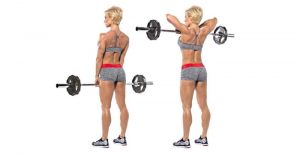
Row with average grip
Using an average grip is one version of the row where you train the middle deltoids and trapezoids. It is more effective than the previous exercise, but it still does not produce broad shoulders. According to research, the muscular activity of the posterior and middle deltoids is 20% less than with a wide grip.
The average grip is the one at which the hands are located at shoulder-width.
In general, beginners perform a large number of repetitions – 20-30. This regimen will allow you to get a feel for which muscles are being worked. On the next day after the workout, the pain in the muscles clearly indicates which area was loaded more than others.
The technique is similar. Just change hand placement.
Wide grip
This position puts the maximum load on the deltoids, which largely determine the shoulder dimensions. The movement is performed this way:
- Lift the bar by tightening the deltoids and trapezius.
- Raise the elbows, but not the forearms and shoulders.
- Keep the back and neck straight, the chin horizontal.
A wide grip requires a very good warm-up of the muscles and joints. But, no matter how qualitative the warm-up was, the range of motion in this grip is reduced. In addition, painful sensations during the performance of the row are not so rare. If you feel these, the Smith machine will save you.
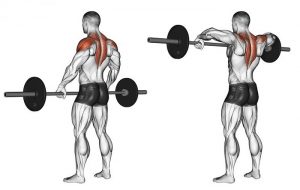
The Smith machine
Exercises with free weights are the foundation of strength training. But the machines have their own advantages. The Smith machine is a sliding bar enclosed in a rigid frame. The question may arise: if the weight limits are those of an ordinary barbell, why switch to the machine? The answer is that the row in the Smith machine is done with one hand. The trajectory is still fixed, but the discomfort disappears. Along with this, the amplitude increases – now it really is a stretch to the chin. Then, when using a wide grip, you barely touch the collarbone.
Row in Smith machine:
- Take the bar in one hand so that the arm position corresponds to the wide grip position.
- Lift the bar to the peak point, directing the bar with your elbows.
Nothing new, everything is the same. In the Smith machine, don’t do forced repetitions. The load on the shoulder joints is too much, and you run the risk of injury.
The advantage of this option:
- Increase in size
- Improve concentration, not being distracted by keeping the balance
- Heavier weights; at first glance, it may seem that the weights in the machine will fall, but in fact everything happens the other way around. Since you don’t need to spend energy on balancing the bar, this method increases by 10-15%; the same as not using the machine.
- No discomfort in the shoulder joints and wrists.
Rows are also well-suited for women. In addition, women can use machines and dumbbells. The latter are universal and, if you notice, they work in a Smith machine. The bottom line is that dumbbells and a machine allow you to bypass the weight limit, add efficiency, and avoid pain.
Recommendations for the exercise pull the barbell to the beard
The main goal of the exercise is the middle deltas, the middle and upper part of the trapezoid. In order to achieve their maximum contraction, it is extremely important to observe the correct form of movement: the elbows should always rise vertically, strictly in the plane of the torso and be apart at the same time. If, when raising your elbows, you direct them at least slightly forward, beyond the line of the body, then the load will immediately shift from the middle deltas to the front ones.
The distance between the arms should be slightly less than the width of the shoulders. Such a grip is better than any other suitable for raising the elbows as high as possible and does not interfere with the correct trajectory of movement. If you grab the neck with a too narrow grip, this will provoke your elbows to move forward, thereby limiting the amplitude of movement. The weight of the rod should not interfere with the observance of the correct technique. Keep in mind: too much weight will not allow you to raise your elbows as high as possible.
It is very important to observe the correct posture! Therefore, you should not relax the muscles of the abdomen and lower back until the end of the exercise, firmly keep the torso straight, with shoulders slightly laid back, during the entire approach. If you relax the stabilizing muscles (press and flexor of the spine), this will inevitably lead to a rounding of the back in the lumbar region, as a result of which you can get a spinal injury. In addition, rounding your back, while raising your elbows, you will push your shoulders forward, as a result – the load on the middle deltas and trapezoid will decrease. Holding your breath while you pull the barbell to your chin will help you keep your torso upright and increase your strength by 20%. Pay special attention to the fact that if you exhale before the barbell reaches the chin, the lower back and torso will involuntarily relax and the load will shift from the working muscles to the spine.
Chin rod pull with emphasis on deltas
Analysis of the exercise pulls rod to the chin with an emphasis on pumping deltas. Basic exercise. Accentuated includes the middle beam of the shoulder and a little back. This exercise is best placed second in your shoulder workout after a barbell or dumbbell press.
A bit of theory. The deltoid muscles of a person perform two main functions: they repel weight from the body and attract weight to it. Accordingly, in order to develop the maximum huge shoulders, you need to use both of these functions. The first function is used mainly in various types of presses (including from behind the head), and the second in all rods, or in their modifications (for example, swing the dumbbells to the sides).
Interesting fact. The pull of the bar to the chin is not done to the chin. The bar should not rise above the chest (more precisely, its upper point). It is necessary to completely relax your hands and pull the bar exclusively with your elbows to turn off the biceps and forearms from work. At this moment, the shoulder is maximally included in the work.
There are two options for performing the movement. With a straight neck and curved. When you make a thrust with a curved neck, you usually take it in the place of the upper bend. And this is the main problem. With this grip, you can’t change the width of the grip and adjust it for yourself. Because of this, it is not possible to correctly raise the elbows to the sides. You take the bar very narrowly, and the biceps, forearm, and trapezoid are included in the work. When you take the bar with a very wide grip, then the movement occurs with a very small amplitude (insufficient for pumping the deltas). Perfect grip – slightly wider than shoulders.
We also set our legs slightly wider than our shoulders, make a slight forward slope and take the bar with the necessary grip (we keep the back exactly as with deadlift). On inspiration, pull the bar up as smoothly as possible. Also gently lower to the starting position on the exhale. Do not raise the bar above the chest, because, in the event of such a lift, a trapezoid is already included in the work.
Recommendations for athletes
At the end of this article, take a look at a few recommendations that will help improve training results:
- Alternate grips.
- Watch the position of the elbows – they should always be above the shoulders and neck.
- At the peak point, hold for 1-2 seconds, then smoothly lower the bar.
- Use support straps when working with large weights, unless you have a very powerful grip.
- Number of repetitions: heavy – 4-6; medium – 6-10; light – 10-20;
- Rows with a barbell are more suitable for men; women, unless they are engaged in strength training, should train with dumbbells and simulators.
- If your wrists hurt, use elastic bandages or wristlets.
- Keep your neck straight and in line with the rest of your body.

